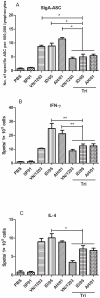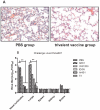Multiple-clade H5N1 influenza split vaccine elicits broad cross protection against lethal influenza virus challenge in mice by intranasal vaccination
- PMID: 22279575
- PMCID: PMC3261182
- DOI: 10.1371/journal.pone.0030252
Multiple-clade H5N1 influenza split vaccine elicits broad cross protection against lethal influenza virus challenge in mice by intranasal vaccination
Abstract
Background: The increase in recent outbreaks and unpredictable changes of highly pathogenic avian influenza (HPAI) H5N1 in birds and humans highlights the urgent need to develop a cross-protective H5N1 vaccine. We here report our development of a multiple-clade H5N1 influenza vaccine tested for immunogenicity and efficacy to confer cross-protection in an animal model.
Methodology/principal findings: Mice received two doses of influenza split vaccine with oil-in-water emulsion adjuvant SP01 by intranasal administration separated by two weeks. Single vaccines (3 µg HA per dose) included rg-A/Vietnam/1203/2004(Clade 1), rg-A/Indonesia/05/2005(Clade 2.1), and rg-A/Anhui/1/2005(Clade 2.3.4). The trivalent vaccine contained 1 µg HA per dose of each single vaccine. Importantly, complete cross-protection was observed in mice immunized using trivalent vaccine with oil-in-water emulsion adjuvant SP01 that was subsequently challenged with the lethal A/OT/SZ/097/03 influenza strain (Clade 0), whereas only the survival rate was up to 60% in single A/Anhui/1/2005 vaccine group.
Conclusion/significance: Our findings demonstrated that the multiple-clade H5N1 influenza vaccine was able to elicit a cross-protective immune response to heterologous HPAI H5N1 virus, thus giving rise to a broadly cross-reactive vaccine to potential prevention use ahead of the strain-specific pandemic influenza vaccine in the event of an HPAI H5N1 influenza outbreak. Also, the multiple-clade adjuvanted vaccine could be useful in allowing timely initiation of vaccination against unknown pandemic virus.
Conflict of interest statement
Figures





Similar articles
-
Inactivated and adjuvanted whole-virion clade 2.3.4 H5N1 pre-pandemic influenza vaccine possesses broad protective efficacy against infection by heterologous clades of highly pathogenic H5N1 avian influenza virus in mice.Vaccine. 2011 Oct 26;29(46):8330-7. doi: 10.1016/j.vaccine.2011.08.091. Epub 2011 Sep 10. Vaccine. 2011. PMID: 21911027
-
Cross-clade protection against HPAI H5N1 influenza virus challenge in BALB/c mice intranasally administered adjuvant-combined influenza vaccine.Vet Microbiol. 2010 Nov 20;146(1-2):17-23. doi: 10.1016/j.vetmic.2010.03.024. Epub 2010 Mar 31. Vet Microbiol. 2010. PMID: 20888151
-
Cross-protection against lethal H5N1 challenge in ferrets with an adjuvanted pandemic influenza vaccine.PLoS One. 2008 Jan 2;3(1):e1401. doi: 10.1371/journal.pone.0001401. PLoS One. 2008. PMID: 18167560 Free PMC article.
-
A systematic review and meta-analysis of cross-reactivity of antibodies induced by oil-in-water emulsion adjuvanted influenza H5N1 virus monovalent vaccines.Vaccine. 2017 May 31;35(24):3162-3170. doi: 10.1016/j.vaccine.2017.04.029. Epub 2017 May 5. Vaccine. 2017. PMID: 28483200
-
Prepandemic influenza vaccine H5N1 (split virion, inactivated, adjuvanted) [Prepandrix]: a review of its use as an active immunization against influenza A subtype H5N1 virus.BioDrugs. 2008;22(5):279-92. doi: 10.2165/00063030-200822050-00001. BioDrugs. 2008. PMID: 18778110 Review.
Cited by
-
Broadening the H5N3 Vaccine Immunogenicity against H5N1 Virus by Modification of Neutralizing Epitopes.Viruses. 2017 Dec 23;10(1):2. doi: 10.3390/v10010002. Viruses. 2017. PMID: 29295514 Free PMC article.
-
Monoclonal Antibody Targeting Neutralizing Epitope on H5N1 Influenza Virus of Clade 1 and 0 for Specific H5 Quantification.Influenza Res Treat. 2013;2013:360675. doi: 10.1155/2013/360675. Epub 2013 Mar 5. Influenza Res Treat. 2013. PMID: 23533740 Free PMC article.
-
Characterization of the 2009 pandemic A/Beijing/501/2009 H1N1 influenza strain in human airway epithelial cells and ferrets.PLoS One. 2012;7(9):e46184. doi: 10.1371/journal.pone.0046184. Epub 2012 Sep 26. PLoS One. 2012. PMID: 23049974 Free PMC article.
-
Seroprevalence of antibodies against highly pathogenic avian influenza A (H5N1) virus among poultry workers in Bangladesh, 2009.PLoS One. 2013 Sep 5;8(9):e73200. doi: 10.1371/journal.pone.0073200. eCollection 2013. PLoS One. 2013. PMID: 24039887 Free PMC article.
-
Inactivated Influenza Vaccine That Provides Rapid, Innate-Immune-System-Mediated Protection and Subsequent Long-Term Adaptive Immunity.mBio. 2015 Oct 27;6(6):e01024-15. doi: 10.1128/mBio.01024-15. mBio. 2015. PMID: 26507227 Free PMC article.
References
-
- Yamada T, Dautry A, Walport M. Ready for avian flu? Nature. 2008;454:162. - PubMed
-
- Qiu J. China boosts pandemic surveillance. Nature. 2009;460:1066. - PubMed
-
- Stone R. Swine flu outbreak China first to vaccinate against novel H1N1 virus. Science. 2009;325:1482–1483. - PubMed
-
- Huang YH. 2009 novel H1N1 influenza: the impact of viral genomic reassortment on immune evasion and vaccine strategy. J Chin Med Assoc. 2009;72:281–282. - PubMed
-
- World Health Organization website. Antigenic and genetic characteristics of zoonotic influenza viruses and development of candidate vaccine viruses for pandemic preparedness. Available: http://www.who.int/csr/disease/avian_influenza/guidelines/2011_09_h5_h9_.... Accessed 2011 Sep 21. - PubMed
Publication types
MeSH terms
Substances
LinkOut - more resources
Full Text Sources
Other Literature Sources
Medical

